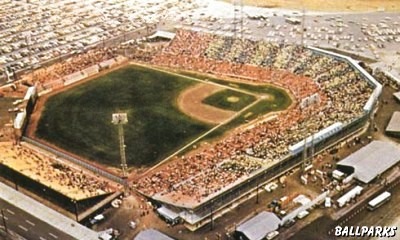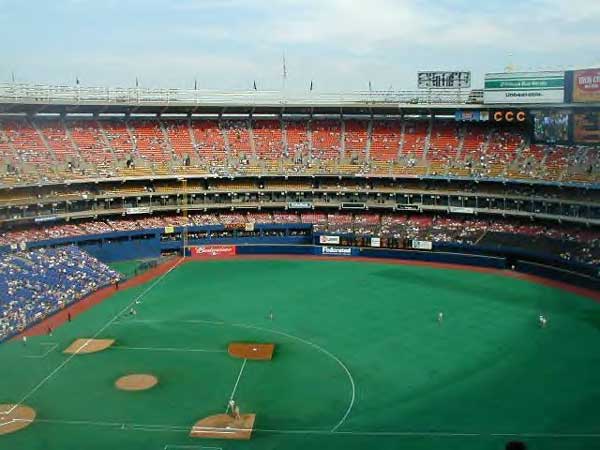 PNC Park
PNC Park

Shibe Park

Wrigley Field [Los Angeles]

Metropolitan Stadium

Crosley Field

Ebbets Field

Sicks Stadium

Arlington Stadium

Forbes Field

Sportsman Park

Old RFK Stadium

Shea Stadium

Colts Stadium

Jarry Park

Exhibition Stadium

War Memorial Stadium

These Shouldn't Have Been Built
Tropicana Field

The HHH Metrodome

Network Associates Coliseum

Pro Player Stadium

County Stadium

Three Rivers Stadium

Candlestick Park

Busch Stadium - 1980's


I am a 49 year old father of six, currently living in Pocatello, Idaho. I was born in the Middle East, but moved to the Washington D.C. area when I was a young man. I became a Senators fan because of all the free tickets I got from Bill Gormley and "Countdown Carnival" on WTTG channel 5. One of the benefits of having a "Carnival for Muscular Distrophy" was free tickets to Senators' games. As a young man from the Middle East, I didn't understand the rules of baseball at first, but I so enjoyed the atmosphere of D.C. Stadium during the game.
I went from fan to fanatic in 1969, the year I turned 13 and the year the Senators had their only winning record. I listened to every game on the radio, and watched all 16 games on WTOP channel 9. Frank Howard, Mike Epstein and Kenny McMullen were my heroes. I spent my hours at school sketching the team's script "W" on their cap, and the "Senators" lettering on the jersey. Virtually every waking hour was spent in some capacity with my Senators.
Bob Short broke my heart in 1971 when he moved the Senators to Texas. I should have seen it coming, since he was the one who moved the Minneapolis Lakers from Minnesota to Los Angeles. For a year, he fought with the D.C. Armory Board, a fight he had no desire to win. He traded his best players before the start of 1971 season to further subdue interest in the community, making his request to move the team more reasonable for the other owners.
Although the Nationals have helped fill that hole caused by the transfer of the Senators to Texas in 1971, I still miss the team and its players.
Osteen To Dodgers A Good Trade

At first blush the trading of Claude Osteen in 1963 looks bad. After all, Osteen won almost 200 games and had a career ERA of 3.30. Man, the Senators could have used him during the 1960s, right? Well, sure, but you've got to look at the other side of this trade. In return, the Senators got Phil Ortega, Pete Richert [later traded to get Mike Epstein], Ken McMullen and Frank Howard. All of a sudden, the trade doesn't seem so bad, does it? Considering the Senators got Osteen for first baseman Dave Sisler, and it was a win-win all the way around.
This was without question one of the best trades in the Senators short history.
Ryan Zimmerman Is Considered The Key To The Nationals Future

Finally, Ryan Zimmerman has cooled off a little bit. After starting his career hitting .532 with 2 home runs, he has gone 1-8 in his last two games, and is hitting .250 at Harrisburg. These numbers don't really matter. Zimmerman, in just a few short games as a professional,has shown that 1]his glove is major league ready today and 2]he has the stroke and the quickness to have a successful major league career. He has line drive power, sprays the ball to all fields, and makes contact.
Who will he remind us of? Probably Chipper Jones, maybe with a little less power but a little more average, and a lot better glove.
Now you be listening for those footsteps, OK Vinny?
Welcome Back, Joey!

When Joey Eischen dove for that swinging bunt against the Mets "that" Sunday night, I thought the lanky lefty would be out for the rest of the season. He screamed. He cried. He writhed in pain. But like the rest of the Nationals' team, Eischen is a gamer, and he placed the needs of his team [specifically, a left hander in the bullpen] over the pain of a fast-pace rehab.
Thank you, Joey. We needed you. First place teams have to have at least one lefty in the bullpen, and it's you, baby!
Sand Gnat Savior: Steve Mortimer

Steve Mortimer is a 24 year old lefthanded first baseman from Washington State University. For the year, Mortimer is hitting .275 with 9 homers and 40 rbi's. He should end the season with 20+ homers and 80+ rbi's, good power numbers for the South Atlantic League. Mortinson went undrafted after completing his eligibility in Pullman, so to stay in shape the athletic first baseman played a year on the Washington State football team. He eventually signed as a free agent with the Expos. Is he the top first baseman prospect in the Nationals organization? Of course not. But he is a good player and should get a shot at the major leagues at some point in his career, though I'm not sure that it'll be with with Nats. He'll have to leapfrog Larry Broadway at New Orleans and Nick Johnson in Washington. That being said, it's always fun to watch the kids try to make a name for themselves.
The Nationals Are Closer "Rich"

[June 23rd] Chad Cordero is not the only "lights out" closer" signed to a Nationals' contract. The Savannah Sand Gnats have a young man who is doing just as well, maybe a little better.
23 year old Brett Campbell is a 34th round draft pick from the University of Georgia. A relief pitcher his entire career, he is overpowering the South Atlantic League every night he pitches. Campbell is 3-0 with a "Cordero like" 1.22 ERA. He has saved 14 games so far for the Sand Gants.
It will be interesting to see what the Nationals do as Campbell progresses up through the minor league system. There is no possible way that Campbell will supplant Cordero. Will he become a middle reliever, or more likely, will he be traded to a team in desperate need of a closer in two or three years? It'll be interesting to see how this plays out. Regardless, it's great to have depth at such a thin position.
So How's That Marlon Byrd / Endy Chavez Trade Looking These Days?

It's been a month or so since the Endy Chavez for Marlon Byrd Trade. How are things looking for the two players? Marlon Byrd is currently at .296 with no homers and 12 rbi's, and has become an invaluable part of the Nationals outfield. Chavez is batting .163 with no homers and 2 RBI's, and isn't getting much playing time these days.
I never understood this trade from the Phillies perspective. Byrd had a great rookie year, batting .303 with 7 homers and 45 RBI's. He played the outfield well and showed good speed. His 2004 season was a bit of a downer, but the Phillies quickly grew tired of Byrd and traded him for Chavez, a player who has proven that he doesn't have the tools to be a leadoff hitter in the major leagues, and he doesn't have the power to do anything else.
I think the Phillies gave up too early on Byrd, and trader Jim Bowden fleeced Ed Wade in getting this deal done. Byrd still has the talent and potential to be an everyday outfielder.
The Ghost Of Senators Past

Each time I watch the Nationals take the field at RFK Stadium, seeing those classic red caps with their script "W" transports me back three decades to an earlier era when a different generation of players, though no less loved, sprinted across the green grass of RFK. Frank Howard, Del Unser and Ken McMullen are connected to Nick Johnson, Vinny Castilla and Ryan Church by that beautiful red cap. The basic design was first used in 1963 when the Senators dropped the block "W" on the cap that the team had used for decades. The cap was blue with a red "W" and had red piping along the seams of the panel sections.

The blue cap was never a favorite of the fans or the players. The red piping made the players heads look much wider than they acutally were. This cap was used with a blue pinstriped uniform with "Senators" in red script along the front of the jersey.

In 1968, the team first used the all red cap with the blue outlined "W" that the Nationals use today. The pinstripes were changed to red the same year.

In 1969, the pinstripes were removed, and the uniform remained unchanged until the the team moved to Texas following the 1971 season.








































